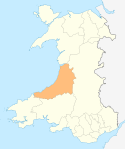Henfynyw
| Henfynyw | |
|---|---|
 | |
Location within Ceredigion | |
| Population | 1,045 |
| OS grid reference | SN 4511 6113 |
| • Cardiff | 69.6 mi (112.0 km) |
| • London | 183.5 mi (295.3 km) |
| Community |
|
| Principal area | |
| Country | Wales |
| Sovereign state | United Kingdom |
| Post town | ABERAERON |
| Postcode district | SA46 |
| Post town | LLANARTH |
| Postcode district | SA47 |
| Police | Dyfed-Powys |
| Fire | Mid and West Wales |
| Ambulance | Welsh |
| UK Parliament | |
Henfynyw (Welsh pronunciation: [henˈvənɪu̯]) is a village and community in the county of Ceredigion, Wales, just outside Aberaeron, and is 69.6 miles (111.9 km) from Cardiff and 183.5 miles (295.4 km) from London.[1][2] In 2011 the population of Henfynyw numbered 1045, with 54.3% of them able to speak Welsh.[3] The community includes the villages of Ffos-y-ffin, Llwyncelyn and Derwen-gam
Henfynyw church and St. David
[edit]By the twelfth century, Henfynyw church was dedicated to St. David, and early Christian lore had it that Henfynyw was the place where St David had spent some of his early years. For instance, the 'Holy Bard of Brecon' (Gwynfardd Brycheiniog, flourished 1176 AD) drew on this lore, when he included Henfynyw church in a poem. His "Ode to St David" listed the places in Wales that were then closely associated with St. David...
- "And fair Henfynyw, by the side of the glen of Aeron,
- Fields prolific in clover, and woods full of wealth."[4]
There is now no sure evidence for Henfynyw in the life of St. David, but Henfynyw church is ancient and has an inscribed stone in the east wall dated to the period 600–800 AD.
References
[edit]- ^ Bangor University Placenames Unit (Canolfan Bedwyr); Archived 23 September 2015 at the Wayback Machine accessed 9 May 2014
- ^ Google Maps (Map). Google.
- ^ Welsh Government website; 2011 Census Returns and stats; Archived 30 May 2014 at the Wayback Machine accessed 9 May 2014
- ^ Lines from the "Ode to St David" translated in the article "Aberaeron before the Harbour Act of 1807", Ceredigion: Journal of the Cardiganshire Antiquarian Society, Vol. 9, Nos. 1–4, 1980–1983.
See also
[edit]



